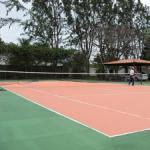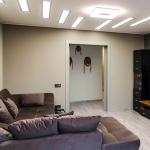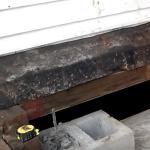Hello, friends. Summer is coming and it's time to think again about cooling our everyday gadgets - this article will focus on a laptop. If in a stationary computer the issue of cooling can be solved with 10 options, then in a laptop you don’t have to choose. In stores for additional cooling of laptops, cooling pads of various shapes and sizes are available, as well as in active and passive versions.
Let's figure out what an active and passive laptop stand means. A passive laptop stand is usually an aluminum or less commonly plastic plate with legs with many holes or a mesh in the middle, which raises the laptop above the table surface, which allows the laptop to freely suck in cool air from under it. I remind you that the air intake holes in laptops are at the bottom, and hot air exits from the side. In different laptop models, the size of the holes and their position on the side surfaces varies. But what remains unchanged is that the air intake from below, the air outlet from the side. And now what is an active stand. The active stand is essentially the same plate of aluminum or plastic with holes as in the passive version, but one large or several small fans are attached to it from below, which force cool air to blow over the bottom of the laptop.
IMPORTANT! For better cooling, the fan should be placed directly under the intake vents of your laptop.
Active laptop stands can have several power options - from the mains (via a 12V adapter) and from a USB connector. In my homemade product, I tried both options, but having encountered certain difficulties, I settled on powering the stand from the mains through an adapter.
So, where did I start my homemade. First walked around the house in search of materials and spare parts. It was found: a 120x120 cooler (in an old dusty case), a 5mm thick PVC foam sheet (used for making advertising signs), a USB extension cable (of which there were about a dozen at home). Why did I stop at foamed PVC, and did not take, say, a steel sheet (the wall of the system unit). Because this material is light and strong enough to support the weight of a laptop, it is also easy to process and can be easily glued with a glue gun.
To begin with, I took a sheet of PVC and put a laptop on it and marked out a rectangle of the required size. With an ordinary jigsaw for metal, I sawed off the excess. Luckily, the remaining piece was enough for two legs and two triangles (stiffening ribs).
Before sawing out the legs, I marked out a fan hole, which I placed directly below the air inlet on the laptop. What is it for? And so that the stand does not rest on the table with a fan, but stands on legs. After drilling four holes with a 4mm drill bit for fasteners, I attached the fan, after which I marked the legs so that the fan did not touch the table. Then I sawed out the remaining parts and holes, after removing the fan.
How to properly position the legs on the stand. The laptop itself has 4 rubber feet. The legs of the stand should be directly below them. This will increase the strength of the structure. And so, the meta gluings are marked, the hot-melt gun is prepared for work, and while it is warming up, we go through the places where the hot-melt adhesive is applied with a fine sandpaper! This will improve the bonding of the parts. Next, glue all the parts and screw the fan into place.


In a minute, the stand is ready! And it remains only to connect the fan. Initially, I wanted to connect the fan to the laptop's USB port. I cut the connector on the fan and stripped two wires:
Black (-) and Red (+) .
Next, I cut off part of the USB extension cable and also stripped only 2 wires (black and red). Then I soldered red to red and black to black and insulated them with electrical tape. This could have ended, but I was a little disappointed.

And so what is the point. And the fact that the fan is 12V, but as it turned out, only 5V in the USB port. Therefore, the fan could not start spinning on its own, and in order for it to work, it had to be pushed with a finger! This was not part of my plans, since for this you need to constantly lift the laptop. After sitting on this problem on the Internet, I came to the conclusion that it would be best to be powered by an external 12 V power supply, this would also allow me to connect the backlight in parallel. It was decided, and I began to rummage around the house in search of a compact adapter or 12 volt power supply. All chargers for phones, alas, at 5V, this did not fit. The power supply from the old 9V modem also did not fit, because it could not start the fan itself. The only available 12V adapter in the house turned out to be a power adapter from an electric shaver. But I found it impossible to cut it, since I use a razor. Therefore, in the nearest radio parts store, a "mother" connector was bought for connecting a power supply from a razor. Wires from the fan were soldered to the contacts of this connector, and wires were also soldered to the LED strip in parallel. Pieces of the LED strip I had left over from the previous handmade project to finalize the backlight of the dashboard of my car. I had pieces of RGB tape, which means I could choose any color of the backlight. by soldering the wires to certain pins on the tape. I wanted a blue backlight, so I soldered the wires with (-) to the "B" (Blue) pin. The LED strip is self-adhesive, so I easily glued it to the bottom of the stand. Dangling wires were glued to the stand with a heat gun. Ready!

Now it's time to try out how the stand assembly works -)))


But for completeness, I decided to paste over the top of the stand with stickers that had been lying around for a long time. I think it turned out well.





And finally, a few words about performance. Checked the cooling efficiency using the OCCT program. Gave load on the processor for 10 minutes. First test without stand.

Then he allowed the processor to cool down to the temperatures of the beginning of the test and launched the test with a stand.

The temperature difference on the processor cores was 6-7 degrees, which is quite comparable with expensive analogues sold in the store. Therefore, homemade work was a success.
Thank you for reading my article, I hope someone will benefit from my experience!
For more than 4 years I have been using a laptop as a replacement for a desktop. After switching to a laptop, a couple of very significant drawbacks were noticed for me: long-term work under load causes quite a lot of heating of the main components and the surface of the laptop, and that the screen level is below the comfort zone. Having suffered a little, at the beginning of 2009 a 4 mm plexiglass stand with 2 120 mm fans was quickly concocted.
Time passed, and in November 2011, I changed my old Acer TravelMate 5520 to a more modern Acer Aspire 5750. The old stand did not fit the new laptop a bit in terms of ventilation holes, tilt angle, and besides, the bent legs got tired and cracked . So it was decided to make a new, improved one.
At first there was an idea to make it from 2-3 mm aluminum sheet, but the search for a suitable material with an acceptable price was not successful. The next idea was to use a cover from an old computer case as a material. At a local flea market, there was an old AT case with a U-shaped lid of suitable sizes.
To begin with, everything was once again measured, estimated and planned. in order not to greatly damage the paint in places where the saw was cut with an electric jigsaw, masking tape was glued.

It’s good that there was still one wall left from the U-shaped cover, with which, after the second time, everything was still cut and drilled correctly:

After preliminary polishing it turned out:


This was followed by cleaning and painting with black matte paint in thin 4 layers. It immediately became clear that I polished a little carelessly - in some places you can see scratches from the sandpaper, and all because of the fact that I was in a hurry. But still, I didn’t remake it, since this place will still be under the bottom of the laptop.
A fan speed controller was also assembled based on the LM2940 voltage regulator (similar circuit), the voltage adjustment range at an input of 11.82V was from 5.24V to 11.62V, the rubber feet were borrowed from the mixer repair kit and put on double-sided tape. The fans I used were 135mm Scythe Slip Stream (SM1425SL12H) which were bought on the cheap over a year ago. The stand is powered by an external power supply 12V 1.5A. The result is a device like this:





The drop in temperature during a cursory measurement on the processor was 7-10 degrees on the video card 8-13.
The project turned out to be very extended in time due to lack of time and opportunities, but in the end it was finally completed and lived up to expectations.
vGamBIT, people.overclockers.ru
Greetings to all habrousers, today I will tell you how I made a simple and pretty budget cooling pad for a laptop.
For this we need:
1) Folder for A4 sheets, with as rough cardboard as possible, in my case it is arch clip binder, looks like this:

2) Fan from a computer measuring 120 by 120 mm:
In my case, this is one of the most budget Gembird FANCASE3 fans, designed for 2100 rpm, that is, “humming like a vacuum cleaner”, but, nevertheless, unscrewed it in my old computer for about three years and still works.
Of course, you can take smaller fans, but 120s have an optimal price / performance / noise ratio.
3) Dismountable USB plug type A (plug / male):

You can, of course, destroy the USB extension cable, but it’s somehow a pity to “put it under the knife”.
4) Centimeters with 10 wires, if you decide to do it, as I:
5) A knife, preferably a sharp one, a screwdriver, a marker / pen, electrical tape or heat shrink (they didn’t get into the lens frame, but they are).
Manufacturing:
To begin with, we need to choose a place where the fan will be, I recommend choosing as close as possible to the end of the folder, and of course, we take into account the location of the laptop's ventilation holes and more, it is advisable to install the fan directly under the hottest parts of the laptop, this is usually a processor or a video card, or both in one person (a video card integrated into the processor), like mine. Someone will probably ask, if you have an integrated video card, then most likely there can be no overheating, then why bother with an additional cooling system? The answer is simple - purely sporting interest, the idea is very simple, and I had everything except the folder.
After we have chosen the optimal location of the fan, or fans (yes, the size of the folder allows you to install two 120 mm fans, if necessary, besides, this will make it possible to give the whole structure rigidity, which is clearly not enough here, but more on that later) you need mark the part to be cut:
Then you need to mark the holes for the fan screws:
It is convenient to do this with a charge from a ballpoint pen:
We are wondering if we have calculated correctly, both from the outside of the folder, where the laptop will stand, and from the inside, where the fan will actually be.
As you can see, I did not manage to make a hole for the fourth screw, so the fan is held on by three.
The distance from the end of the folder I got about 25 millimeters, but I did it specifically for my laptop so that the fan was as close as possible to the hot parts of the laptop.
As you can see, I can’t really draw, so here’s a picture from Wikipedia:

Usually, red fan wire is positive and black is negative, yellow is speed monitoring, it does not interest us, as well as D + and D- USB contacts. So a here IMPORTANT after connecting the wires isolate everything, so as not to accidentally arrange a short circuit for your laptop, which can negatively affect the pet itself, and do not say that I did not warn you.
If you still want to make a USB connector from a USB extension cable, then there is the same, the red wire is a plus and the black one is a minus.
Of course, reduced power will affect the fan speed, it will drop by at least half, so I think 800 rpm fans will not work for this, they may not start at all, ideally something at 1700-2500 rpm. But noisy fans tend to become quiet at these speeds and have more or less some airflow.
And a few more words on installing the fan, I think that it is better to install the fan so that it blows air from under the bottom of the laptop, that is, “stands to blow out”, as they say between “iron workers”. Of course, no one forbids putting it the other way around, but then it will blow all the dust into the inside of the laptop, think about whether it is appropriate to clean the laptop cooling system or not?
The airflow, as well as the direction of rotation of the fan, are indicated on the side of it.
As you can see in the photo, I removed the arched clip, it interfered with me, I believe that it will be for you too, just gently pry it with a screwdriver, however, everything is visible in the photo.
Advantages and disadvantages:
To the pluses can be attributed to ease of manufacture, I think it will not be difficult for anyone to make such a stand, after so many photos that I took, cheapness and flexibility, you can do it specifically for your laptop, for the location of the laptop vents, the pleasure of doing something with your own hands, everyone can buy.
By cons the fragility of the design can be attributed, just take a look:
It seems to me that this is not entirely good, if you have any ideas or thoughts, write in the comments, or I have links to Facebook and VKontakte in my profile. So far I've figured it out like this:
Although I think it would be more correct to do something like this:
I’ll probably also attribute low efficiency to the disadvantages, during the tests my temperature dropped by only 2 degrees, but I think that this is a drawback of the laptop’s cooling system itself, if you unscrew the bottom cover to draw hot air directly from the heat pipes, then there will be a drop in temperature clearly higher.
And the last drawback - since I have an old fan, 3 years after all for a motor with a plain bearing, this is a big line, even for a brushless one, a slightly noticeable “hole”, I believe that this is due to bearing wear.
Make a drawing of the stand. Its width and length should be a couple of centimeters larger than the dimensions of the computer. Mark the air intake holes on the stand. They should be as close as possible to the location of the air intakes on the bottom of your .
Transfer the drawing to a sheet of aluminum or plexiglass. Using a hacksaw, cut out the bottom, top and back covers and side walls of the stand from the prepared sheet. On the top cover, cut out the marked holes for the fans with a grinder.
Making a stand
The drawing can be made not on paper, but immediately on a sheet of metal or plexiglass. To mark the holes for the fans, place the switched on laptop on the top cover of the package. Those places where the lid is very hot, mark - it is here that holes for air intake should be drilled. On the back cover or side face, make a hole for the wires. Sharp and uneven edges of the holes must be processed with a file.
All edges of the stand are fastened with self-tapping screws. To do this, with pliers or a vice, the edge is bent on each face of the metal sheet at an angle of 90 °, holes for self-tapping screws are drilled and the edges are fastened. The edges of the plexiglass stand are held together with glue.
Manufacturing of the cooling system
To gain access to the fans, one of the covers (preferably the top one) should be made removable. Attach the fan to the bottom cover of the stand with screws or glue.
Assemble the electrical circuit to turn on the fan. A series circuit of a fan, a molex, a USB cable, and a switch. To check the operation of the circuit, assemble it first without soldering. After making sure that everything works, you can solder the wires using solder, rosin and a soldering iron. After soldering, the junctions of the wires are wrapped with electrical tape. If you are going to use several fans, then you need to connect them in parallel.
Stand decoration
Clean the surfaces of the stand from dirt and grease. Using scissors and a knife, cut out all the necessary holes in the self-adhesive film and carefully glue the stand on all sides. Tighten the wires with cable ties that match the color of your stand.
When cutting holes for the fan, cuts may occur. If this happens, then when pasting the surfaces of the stand with a film, place pieces of thin cardboard under it so that the holes look neat and the film does not tear on the sharp edges of the cuts.
Computer technology surrounds us everywhere: at home and at work, in transport and on vacation, but it's no secret to anyone that it requires proper care and handling.
For example, a laptop needs a special stand that will help cool it, which means it will extend its life. In addition, the laptop on it is at an angle, and it is more convenient for us to use it in this position.
We all understand that modern computer technology is becoming an integral part of our lives. Until quite recently, we could not even imagine that even small children would easily master computer literacy. Personal computers and laptops, tablets and e-books, printers and scanners, game consoles and smartphones, video recorders and navigators have become as familiar gadgets as TVs. Today it is already difficult to find a house in which there is not at least one of them.
Let's try to make a laptop stand with our own hands.
Step 1: Selection of materials and tools
Selection of materials and tools
We will need:
- about one and a half meters of PVC pipe (2 cm in diameter),
- connecting PVC elbow (2 cm in diameter), 90° - 6 pieces,
- a hacksaw or a mechanical jigsaw,
- a bottle of spray paint of any color,
- marker,
- roulette,
- sandpaper,
- damp cloth
- glue for PVC products (optional).
Step 2: Marking the PVC Tube
PVC pipe marking 
1. Stretch the tape measure along the entire length of the PVC tube, starting from the left edge.
2. Using a marker, make marks on the tube at 25cm, 43cm, 61cm, 67.5cm, 74cm.
Step 3: Segmentation
Segmentation
1. Grasp one end of the tube with your left hand, press the other end to the table.
2. Take a saw or a jigsaw in your right hand and cut the tube into segments according to the markup.
Step 4: Arranging segments
1. After cutting the tube, place the segments on the table in order (from smallest to largest).
Step 5: Assemble Part A

1. Take a piece of tubing 25cm long and attach connecting elbows on each side.
2. To attach the elbow, insert one end of the tubing into the hole in the elbow.
3. Rotate the tube from side to side to make it easier to insert.
4. Make sure both knees are pointing in the same direction.
Step 6: Assemble Part B
Attach one piece of tubing 6.5 cm long to the free end of each of the two elbows.
Step 7: Assemble Part C

1. Attach 1 more knee to each free end of the segments (6.5 cm).
2. Position each knee so that its free end is up.
3. Temporarily set this design aside.
Step 8: Assembling Part D
1. Attach one of the remaining knees to each 18cm piece.
Step 9: Final Assembly
1. Connect one of the 18 cm lengths (with an elbow at the end) to the free hole of the elbow of the finished triangular structure.
2. Repeat the same procedure with the second 18 cm piece.
3. Point your free 2 knees towards you.
Step 10: Troubleshooting
1. Rotate each elbow-tube connection to make sure the connection is secure.
2. Measure the corners. Turn the whole structure upside down, press it lightly around the entire perimeter to make sure that all four points of contact of the structure with the table are stable.
Step 11: Folding for storage
Fold two 18cm lengths of PVC tubing inward until they form a rectangular structure.
Step 12: The optional final step
Finished stand
1. Glue all structural elements together using PVC glue.
2. Wipe the structure with a damp cloth to remove all dirt.
3. Paint the structure with spray paint.
Laptop stand is ready!


















